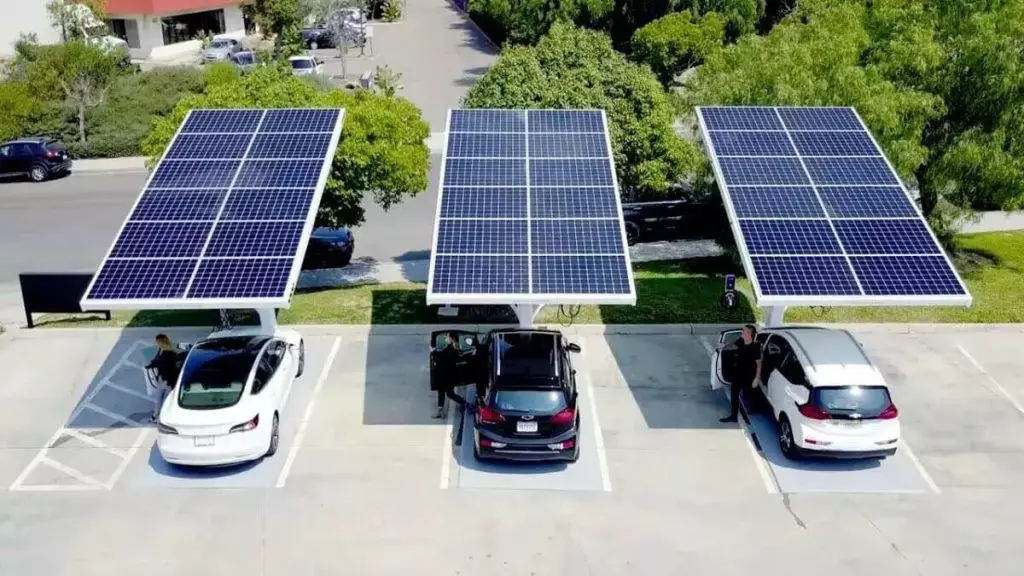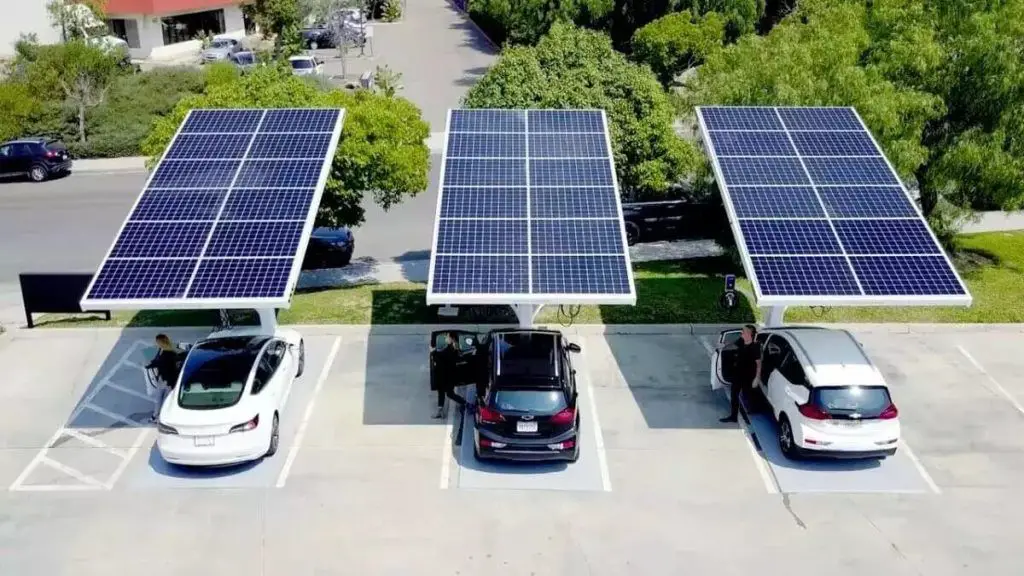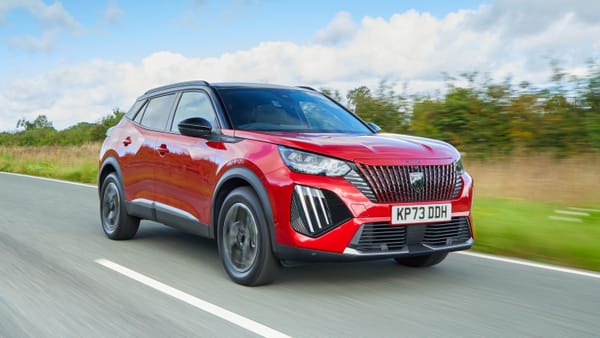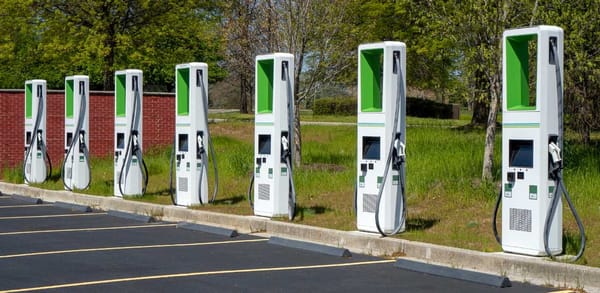How Much Solar Do I Need to Charge My Electric Car?
unlight when converted into power by solar panels, can be used to recharge an electric car’s battery. To power your EV, you can harness renewable energy by installing a solar photovoltaic (PV) system, which will lessen your reliance on fossil fuels and your carbon impact.


Sunlight when converted into power by solar panels, can be used to recharge an electric car’s battery. To power your EV, you can harness renewable energy by installing a solar photovoltaic (PV) system, which will lessen your reliance on fossil fuels and your carbon impact. Solar-generated power can be utilized immediately to charge the electric vehicle or it can be stored in batteries for later usage. A sustainable and economical method of transportation is to use solar energy to charge your electric vehicle.
Read: Is solar power the future of electric vehicles?
Semiconductor components used in these panels, like silicon, absorb solar energy and use the photovoltaic effect to produce an electric current. An inverter can change the direct current (DC) electricity generated by solar panels into alternating current (AC) electricity, making it work with common electrical systems.
There are a few ways to connect solar panels to Electric Vehicle chargers. The first option is to use a dedicated solar charger, which is designed specifically for charging EVs. These chargers are usually mounted on the roof of the home or business, and they connect directly to the EV charger. The second option is to use a grid-tied solar system, which is connected to the electrical grid. The solar panels generate electricity, which is then sent to the EV charger through the electrical grid. EVs can also be charged using portable solar chargers. These devices are small and lightweight, making them easy to transport.
Related: How Much Solar Do I Need to Charge My Electric Car?
One might also be asking how long it takes to charge an electric vehicle using solar panels, it is important to know that an average solar panel can produce around 4 kilowatts of power, which is enough to charge a typical electric vehicle in about eight hours. Solar panels can also be used to charge the batteries of electric vehicles directly, although this method is not as common. It takes longer to charge an EV using solar panels than it does to charge it using a standard outlet, but solar panels are a much more sustainable option in the long run.
To calculate the amount of solar needed to power an EV we will use an example of Tesla to help us in the estimation. A typical solar panel is 250 watts and generates about 30 kWh to 42.5 kWh of energy monthly. On the lower end, you’ll make about 1 kWh of energy daily. This means you’d need around 75 solar panels to charge a Tesla Model S to 100% every day if it starts at 0%. And your electric car will not be as low as 0% every time you charge it, so that’s a conservative estimate.
Everyone’s solar charging situation is different therefore the exact number of panels used to charge an EV depends on the following factors:-
- Fuel efficiency of the EV
- Number of miles traveled per day
- Wattage of the solar panels
- Average hours of sun per day
See: Solar energy to power EV and how to install them
Steps to follow to charge electric vehicles with solar power.
i) Install a photovoltaic (PV) solar power system: Start by adding solar panels to your property, preferably on the roof or in a location that receives a lot of sunlight. Your energy requirements and the amount of sunshine that is available where you are will determine the number and capacity of the solar panels.
ii) Connect the solar panels to an inverter: The solar panels must be connected to an inverter to convert the direct current (DC) electricity they produce into the alternating current (AC) electricity needed to charge the electric vehicle. This conversion is carried out by an inverter, which also makes sure that it is compatible with common charging hardware.
iii) Install an EV charging station: Install an EV charging station, commonly referred to as an EVSE, in your residence or another convenient location. The EVSE controls the charging process and offers safety features as an interface between the solar power system and your EV.
Read: Solar and wind power growth to limit global warming.
iv) Connect the solar system to the EV charging station: Connecting the solar system to the EV charging station requires utilizing the proper wiring to connect the inverter’s output to the EV charging station. This enables the solar energy to be produced to be transferred to the charging station and ultimately to your EV.
v) Monitor and manage the charging process:
Use monitoring software or systems to keep track of the solar power output and energy consumption during the charging process. This helps you maximize the use of solar energy by scheduling charging periods to correspond with solar production peaks.
It’s important to keep in mind that the installation procedure’s specifics may change based on the type of EV, the solar power system, and local laws. To ensure appropriate installation and adherence to local safety requirements and regulations, it is advised to speak with a professional solar installer and an electrician.
Advantages of using solar chargers
i) Reduced Energy Costs:
Solar energy is a free, renewable resource. Once solar panels are erected, using the sun to generate electricity is substantially less expensive than using fossil fuels or buying electricity from the grid. As a result, during the course of your solar power system, you may experience significant cost savings.
Read: Finding a Solution to Fast-Charging Issues
ii) Reduced Dependence on the Grid:
Using solar power to generate your own electricity reduces your dependence on the power grid. This lessens the effect of changing electricity prices, which might change based on elements like demand, fuel prices, and distribution fees. You can avoid potential price rises and enjoy more steady and predictable energy prices by charging your EV directly from solar electricity.
iii) Long-Term benefits:
When installing the solar panel it can be expensive but the long-term benefits may overshadow the costs used when installing. Solar energy production can help reduce or totally replace the demand for electricity which is used to power electric vehicle batteries in most cases.
iv) Potential for Net Metering:
Net metering allows customers to send surplus electricity produced by solar panels back to the grid in exchange for credits. When solar power is insufficient, such as at night or during low sunshine hours, these credits can be utilized to balance the electricity drawn from the grid. This lowers the overall cost of charging your EV even more.
v) Environmental Advantages:
Using solar energy to charge your EV has environmental benefits in addition to economic savings. When used, solar energy creates no greenhouse gas emissions or air pollution, making it a clean and sustainable energy source. Your use of solar energy to charge your EV makes a difference in lowering carbon emissions and supporting environmentally friendly mobility.
Read: Solar panels an alternative for charging electric cars.
vi) Providing Backup Power
While the technology is still developing, it is possible to use the power stored in an EV battery for your home during a power outage, emergency, or natural disaster. Most EVs have batteries large enough to power parts of a home for several days with the energy they store. Additionally, by using solar energy you can also charge your EV during an outage.
In conclusion, we know that solar panels can be used to charge an electric vehicle, but the process is not as simple as plugging the car into the panel. In order to charge your electric vehicle properly using solar panels there are a few things that need to be taken note of such as the size of the solar panel, the amount of sunlight available, and the type of charger that is being used to charge the electric vehicle.
Second, it is important to remember that solar panels will not work during a power outage. This means that if you are relying on solar panels to charge your electric vehicle, you may need another source of power or find a place to plug in during an outage.
Finally, while solar panels can be used to charge an electric vehicle, they are not always the most efficient option. If you are looking for the quickest way to charge your car, it is often better to use a dedicated charger that plugs into the wall. However, if you are interested in saving money on your energy bill or want to be more eco-friendly, then using solar panels may be the best option for you.
Ref:
i) BILITI ELECTRIC (2023) Can You Charge An Electric Vehicle With Solar Panels?




